France: Staff Concluding Statement of the 2017 Article IV Mission
July 17, 2017
Key Points
-
The government’s ambitious reform program could go a long way in addressing France’s longstanding economic challenges—persistent fiscal imbalances, high unemployment, and weak external competitiveness.
-
The emphasis on reducing public spending, to allow gradual fiscal consolidation and tax relief, is appropriate. To make the strategy credible, deep reforms are needed at all levels of government, with major spending efforts from the start.
-
The labor market strategy is broad and ambitious—it would enhance enterprise-level flexibility, reform unemployment insurance, and improve professional training and apprenticeship systems. It should be complemented by continued wage moderation.
-
The planned corporate, capital, and labor tax reforms should boost investment and job growth. To maximize the impact, the package should include measures to reduce the corporate tax debt bias, remove inefficient exemptions, address disincentives to company growth, and streamline the taxation of long-term savings.
1. The new government is pushing ahead with an ambitious economic program to make France’s economy more dynamic and its public finances sustainable. The envisaged labor and tax reforms are aimed at boosting growth, employment, and competitiveness. And the government has rightly emphasized the need to rein in the high level of public spending, which would help gradually reduce the budget deficit and debt while creating room for fiscal maneuver and tax relief. For the strategy to work, it will be critical to exercise spending restraint from the start and undertake structural expenditure reforms at all levels of government. With a strong political mandate and economic conditions improving—growth is on track to reach 1½ percent this year and further accelerate next year—there is now a unique window of opportunity for such a bold and comprehensive economic reform package.
Fiscal policy
2. The government’s proposed gradual fiscal consolidation path is appropriate, targeting a budget that comes close to balance by 2022. This would help place public debt—which is approaching 100 percent of GDP—on a downward trajectory without unduly detracting from the recovery. The central pillar of the strategy is to bring down government spending by over 3 percentage points of GDP by 2022. This is appropriate as the high level of government spending has long been at the heart of France’s fiscal problems.
3. Strong actions are needed from the start, given the spending slippages identified in the recent Cour des Comptes audit and the frontloading of tax relief of almost ¾ percent of GDP. For 2017, meeting France’s commitment to bring the deficit down to 3 percent of GDP requires major efforts, including horizontal spending freezes, which are well underway. For 2018, the spending effort will have to continue and become more structural, as measures of around 1 percent of GDP will be needed to meet the 2018 deficit objective—an exceptional effort by historical standards.
4. To make the fiscal strategy credible and compatible with growth and social objectives, it will be critical to design and implement deep spending reforms at all levels of government. Comprehensive spending reviews should identify areas for efficiency gains and savings. Local governments would need to be part of these efforts, in a new pact with the state, with an agreed system of monitoring and incentives. Areas for possible reform include:
- The relatively high wage bill could be reduced by shrinking the number of public employees in non-priority areas and reforming the salary system across the different levels and functions of the public sector.
- Restructuring and computerization of administrations could be supported by the €50 billion temporary investment plan announced by the President.
-
Stepping up efforts to consolidate local government, especially the large number of small communes, could yield important economies of scale.
-
Social transfers—notably housing—should be better targeted to the people most in need of support.
-
Health spending could be made more efficient to curtail rising costs, including by reforming hospitals, enhancing the use of generics, and reviewing co-pays and deductibles.
- The envisaged reform of the pension system, which intends to unify different regimes and introduce a points-based or notional accounts system, should include incentives for later retirement.
Labor market
5. To improve the dynamism of the labor market, the government is moving fast to enact a major reform package in September. This will redefine the scope of branch and firm-level agreements to give greater flexibility for negotiations at the enterprise level, streamline the social dialogue, reduce judicial uncertainty around dismissals, and introduce a more flexible contract type for projects. The planned reform of unemployment insurance system, giving a greater role for the state and expanding coverage to the self-employed, would be an important opportunity to strengthen job search incentives through the institutional support and control framework.
6. The envisaged reforms of the professional training and apprenticeship systems will be critical, especially as France’s unemployment problem affects the young and the low skilled far more than others. Here, the resources from the investment plan announced by the President can be leveraged to adapt the system to labor market and individual needs, including by improving quality control, simplifying access, and strengthening the link between professional education and private sector employers. Continued wage moderation will be critical to support job growth and competitiveness—this could be supported by enhancing firm-level flexibility in wage negotiations, limiting increases in the minimum wage to inflation, and giving a strong advisory role to the future National Productivity Board, including guidance on the link between wage dynamics and economic conditions.
7. The plan to further reduce the still sizeable labor tax wedge should support job creation. The government intends to cut employee contributions, financed by an increase in the CSG, and convert the CICE into a permanent payroll tax cut. The transition cost of the CICE conversion, amounting to around 1 percent of GDP, could be defrayed by phasing in the payroll cut over two years.
Productivity and Competitiveness
8. The proposed reforms of corporate income and capital taxation should help boost competitiveness and investment. The planned phased reduction in the corporate income tax rate from 33.3 to 25 percent should be combined with a reduction of the debt bias, for instance by further limiting interest deductions, removal of inefficient tax exemptions, and elimination of the special regime for small business to address disincentives to company growth. Production taxes, which are relatively high in France, should be reviewed. The planned narrowing of the wealth tax and introduction of a unified tax (of around 30 percent) on interest income, dividends, and capital gains would remove distortions. This should be complemented by transforming instrument-based tax breaks—such as for life insurance, real estate investments, and regulated savings—into a general tax-advantaged long-term savings scheme.
9. To support productivity growth and competitiveness, it will also be important to sustain efforts to simplify business regulations and enhance competition in the services sectors. And while the financial system is providing adequate financing to the real economy, it will need to continue adapting its business models to the low interest rate environment, new technologies, and changing regulatory standards.
We thank the authorities for the constructive discussions.
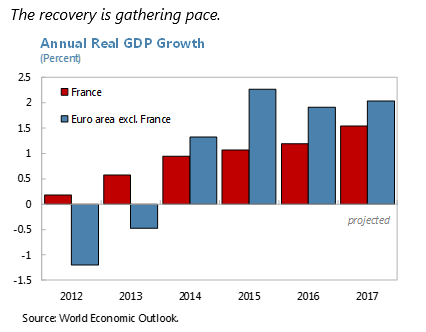
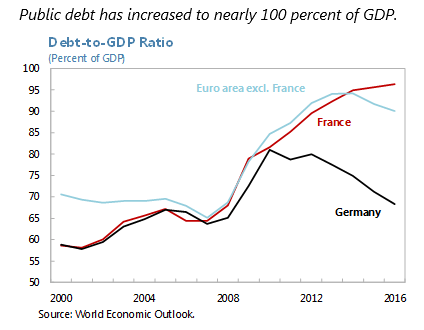
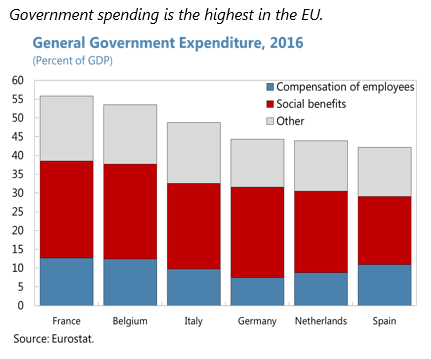
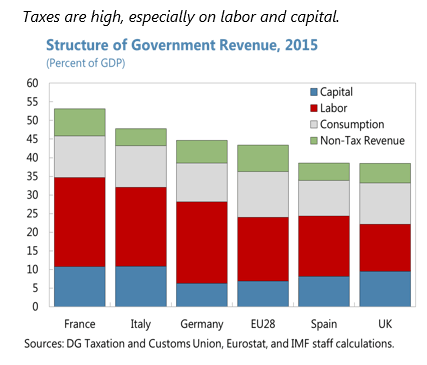
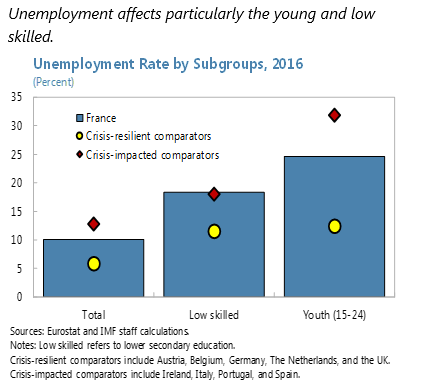
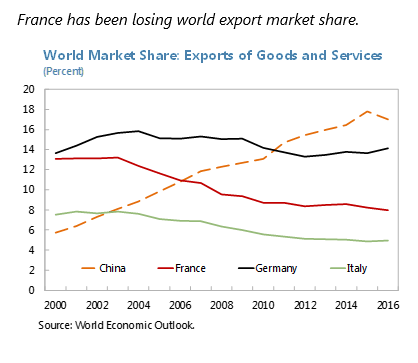
IMF Communications Department
MEDIA RELATIONS
PRESS OFFICER: Bruno Silvestre
Phone: +1 202 623-7100Email: MEDIA@IMF.org


